وثيقة
Pollutants from the Gulf war serve as water mass tracer in the Arabian Sea.
المعرف
DOI: 10.1029/1998GL900259
المصدر
Geophysical Research Letters. v. 26, 1, p. 71-74
المساهمون
الدولة
United States.
مكان النشر
Washington
الناشر
American Geophysical Union.
ميلادي
1999-01-01
اللغة
الأنجليزية
الموضوع
الملخص الإنجليزي
In 1995, concentrations of the chlorofluorocarbon compound CFC-12 in the outflow water from the Persian Gulf were 8-40 fold higher than normally caused by air-sea gas exchange. At that time, the anomaly was restricted to the Gulf of Oman north of 20°N, while in 1998 the signal had spread southwestward to 12°N. The sources of this CFC-12 input of about 6400 kg are most likely the fire extinguishers and solvents used during and after the Gulf War in 1991. This CFC-12 signal is a new feature of the Persian Gulf Water (PGW) which can be used to track and quantify the spreading and dilution of PGW in the northern Indian Ocean. The contaminated PGW spreads southward with a mean velocity of 0.02-0.025 m s-1. At 20°N, the anomaly is diluted by a factor of more than two, and east of the island Socotra by a factor of four. A mean transport of less than 0.5·106 m3 s-1 is calculated for PGW assuming a mean dilution rate of 30% from the source signal in the Gulf of Oman to the western Arabian Sea.
ISSN
0094-8276
قالب العنصر
مقالات الدوريات

